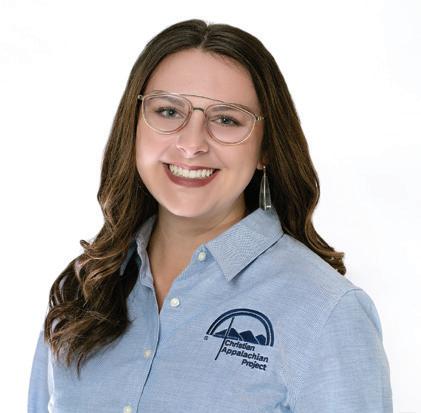
At a glance

• Understand the facets of an IRA charitable rollover
• Learn how gift annuities guarantee income during retirement years
• Beat capital gains with a unitrust



SPRING 2024
Prepared for the Friends of Christian Appalachian Project
Thoughts about our “golden years” are changing. This is a new phase, a time to do things you’ve always wanted, and an opportunity to redefine your priorities.

Financial experts agree that retirees will need at least 70% of their pre-retirement income in savings. Social Security benefits may offer a retirement income base but will not likely provide a fully-funded retirement. Therefore, it is important to heed the advice of investment experts to save 10-15% of pre-tax income and take advantage of tax-deferred opportunities.
Many people who have earned income take advantage of Individual Retirement Accounts (IRAs). There are two types of IRAs. The traditional IRA, which allows both tax-deductible and non-tax-deductible contributions. In either case, all earnings accrue tax-deferred, but upon withdrawal will be taxed as ordinary income. Secondly, there is the Roth IRA, which contributions are not tax deductible but “qualified” withdrawals from the account are taxable. Annual contribution limits are $7,000 for those under 50 and $8,000 for those 50 or older.
Significant advantages exist in giving or bequeathing funds to charitable institutions.”
Retirement may provide you with more time and ability to support charitable causes. There are several options for giving in retirement while also reducing tax burdens.
IRA CHARITABLE ROLLOVER
If you are 72 or older, you are required to take a minimum IRA distribution. Normally, these distributions are subject to income taxes. However, for persons aged 70½ and older, the IRA Charitable Rollover provision allows you to transfer funds to a public charity each year directly from your traditional or Roth IRA without treating the distribution as taxable income. This is also known as a Qualified Charitable Distribution (QCD). The annual limit is now $105,000. Donors may receive no goods or services in return for their contributions and must obtain written documentation of their contribution. To avoid tax, designate that the charity receives the distribution directly from your IRA.
BEQUEATH RETIREMENT
PLANS
TO CHARITY
Significant advantages exist in giving or bequeathing funds to charitable institutions such as Christian Appalachian Project (CAP) from your retirement assets. This can be accomplished by naming CAP as a beneficiary.
The disposition of IRAs, pension, and profitsharing plans is not governed by a person’s will, but rather by beneficiary designation. The participant designates on the beneficiary form who they wish to receive the retirement benefits which remain after death. In the absence of a designation, the primary beneficiary is governed by the plan’s terms. CAP can be named as beneficiary, with the non-participant spouse’s consent. (Spousal consent is not required for an IRA, except in some states.) The designation could take several forms:
• As secondary beneficiary, one’s spouse is named primary beneficiary to receive retirement benefits for their life, then the institution would receive payments of those benefits.
• As contingent beneficiary, meaning that the institution would receive the benefits if the participant’s spouse pre-deceases them.
• CAP could be named as beneficiary for a fraction of the account or for a stated cash amount.
• If the person is survived by descendants, the designation could be to the surviving spouse first for their life and thereafter the balance in the account is divided between CAP and those descendants.
Planned giving is so much more than including Christian Appalachian Project in your will. I’m happy to walk you through other ways to give. Please contact me!


There are distinct tax savings in making testamentary charitable gifts using retirement assets compared to probate assets. Unlike other assets, retirement funds are subject to income tax when distributed, unless the funds are paid to taxexempt charities. At death, if persons other than the surviving spouse or tax-exempt charities are beneficiaries of your retirement funds, these funds are potentially subject to additional estate taxes. Under 2024 estate and income tax rates, if your personal estate is worth more than $13,610,000, the total estate and income taxes on retirement plan assets can reduce the value received by 40%.
If you have an IRA, pension and/or profitsharing plan account balance and you are considering naming CAP as a beneficiary, be sure to consult a lawyer or other tax advisor to properly execute that designation.
THE DEFERRED PAYMENT CHARITABLE GIFT ANNUITY
A deferred charitable gift annuity (CGA) offers an attractive way to make a gift to CAP now while guaranteeing personal annual income when you retire. If you need tax deductions during your peak earning years and supplemental income when you retire, the deferred CGA could be a strong option for you. A deferred CGA would allow you to receive a current income tax deduction for the value of the gift minus the value of your future annuity payments. The following example illustrates this opportunity:
Example:
Jennifer is a 55-year-old accomplished sales executive and supporter of CAP. She is looking ahead to retirement and wants to make certain that she has sufficient annual income at the time she retires. To supplement her taxable investments, Jennifer has decided that a deferred CGA would
accomplish two of her primary objectives: to assist CAP and to provide retirement income for herself. Jennifer is in the 32% income tax bracket.
For this illustration, we will assume that Jennifer currently does not need the income that could be produced by a traditional investment of $50,000 and uses that amount to purchase a deferred CGA. Further, she decides that she wants to begin receiving annual income from the annuity when she reaches age 68. During this 13-year period, the investment accumulates in value on a tax-deferred basis. Then, at age 68, when Jennifer begins receiving income from the deferred CGA, a portion of it will be tax-free.
*Note that this illustration assumes a rate of return that may not be applicable when an actual deferred gift annuity is established.
In this example, Jennifer makes an outright gift of $50,000 to CAP now, during a time when she is earning and her taxes are higher, and guarantees income in her retirement years when she will presumably be in a lower tax bracket. She has also removed $50,000 from her estate, thus reducing potential estate tax liability. Alternatively, Jennifer could have funded a series of gift annuities for $10,000 each year for five years. This planning strategy takes advantage of the fact that payment rates may increase with each new annuity entered into at an older age. A “flexible” deferred CGA would allow Jennifer to take the annuity earlier or later than the target date of 13 years.
Approximate results of this transaction summarized: 1. Principal amount for deferred CGA............................$50,000 2. Number of years payment is to be deferred...........................13 3. Annuity rate....................................................................8.2% 4. Annual annuity payments beginning in 2032................$4,100 5. Amount of annual annuity payment excluded from taxes....................................................$1,566 6. Tax deduction in year of gift........................................$21,988 7. Current year tax savings at 32%....................................$7,036
THE CHARITABLE REMAINDER UNITRUST
In another hypothetical example, we find Sean who has reached retirement age and realizes that several of his investments do not yield the income he desires. Also, since these long-term investments have appreciated significantly in value, he will have to pay a substantial capital gains tax if he sells them.
A solution to this dilemma is a charitable remainder unitrust (CRUT) that works like this:
A donor irrevocably transfers cash, securities, or other property to the trustee, establishing the CRUT. A bank, trust company, some other funds manager, or an individual can serve as trustee. The trust agreement provides that the trustee shall pay from the trust to the donor (or his spouse or other designated beneficiaries) an annual payment, usually for the life of the beneficiaries. The amount of the payment is determined by applying a fixed percentage (not less than 5%) to the trust assets, as valued each year.
The payout percentage is agreed upon when the trust is established. The annual income from a unitrust fluctuates as the value of the trust assets changes, but the payout percentage remains the same. The donor may add to the trust in future years. The trust assets pass to CAP for use in our work when the donor or his other beneficiaries passes away.
Example:
Sean has stock he purchased in 1996 for $20 a share. Today it sells for $200 a share. It is paying Sean an annual dividend of 2%. In retirement, Sean needs more income, but if he sells the stock, he will pay at least a 15% capital gains tax on the $180 gain in price of each share since he purchased the stock. Sean’s federal capital gains tax could be as high as 23.8% if he is in a high tax bracket. Sean creates a unitrust with a 6% annual payout, naming CAP as remainderman,
and transfers his stock to the unitrust. The unitrust sells the stock and replaces it with assets that allow the unitrust to pay the 6% annual amount.
Advantages to Sean:
• The annual income from the asset has tripled.
• He avoided paying immediate capital gains tax. (If the annual ordinary income generated by the unitrust is below 6%, the difference between the ordinary income and 6% will pass through to Sean as capital gains until all of the capital gain inside the unitrust flows out to Sean over the years.)
• He received an immediate charitable income tax deduction for the present value of the trust remainder, computed based upon his age, current interest rates, and the current fair market value of the stock when the unitrust was funded.
• His income will increase if the value of the trust grows over time.
• At death the remaining trust assets will benefit CAP.
I included CAP in my legacy plans because I believe no one should go without adequate food and a safe, dry home.”
Retirement can be a time in our lives when we travel, make memories with our friends and family, and work on behalf of non-profit organizations that perpetuate our values. If we prepare well for retirement, we can indeed find that it will be the best time of our lives.
Ms. Wilson, one of our committed donors, is using this time to reinforce the legacy she wishes to leave in this world. She shared, “I included CAP in my legacy plans because I believe no one should go without adequate food and a safe, dry home.”








